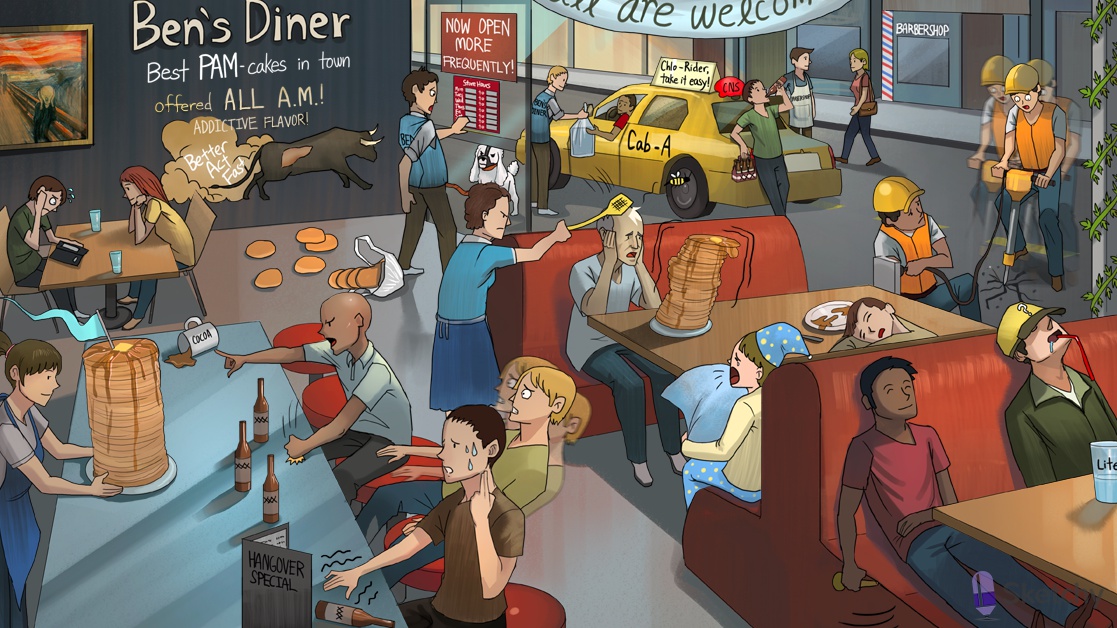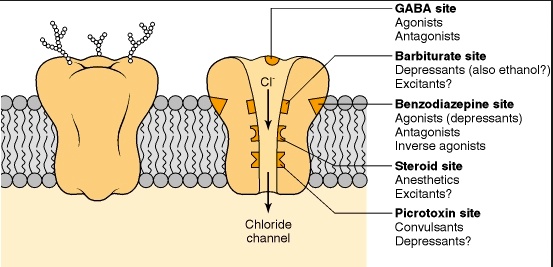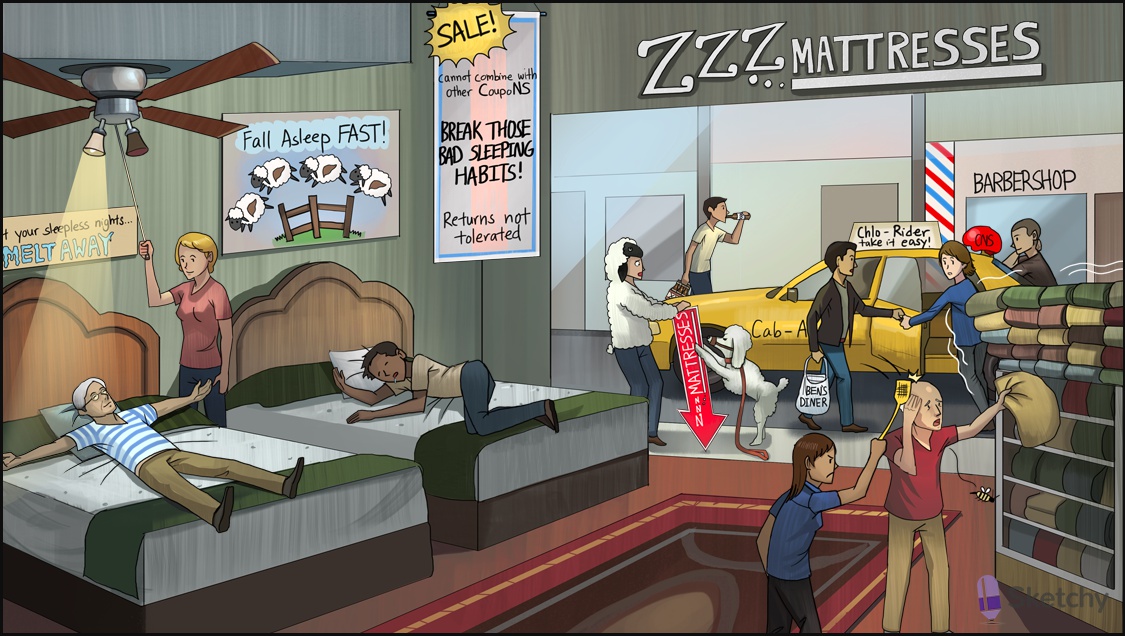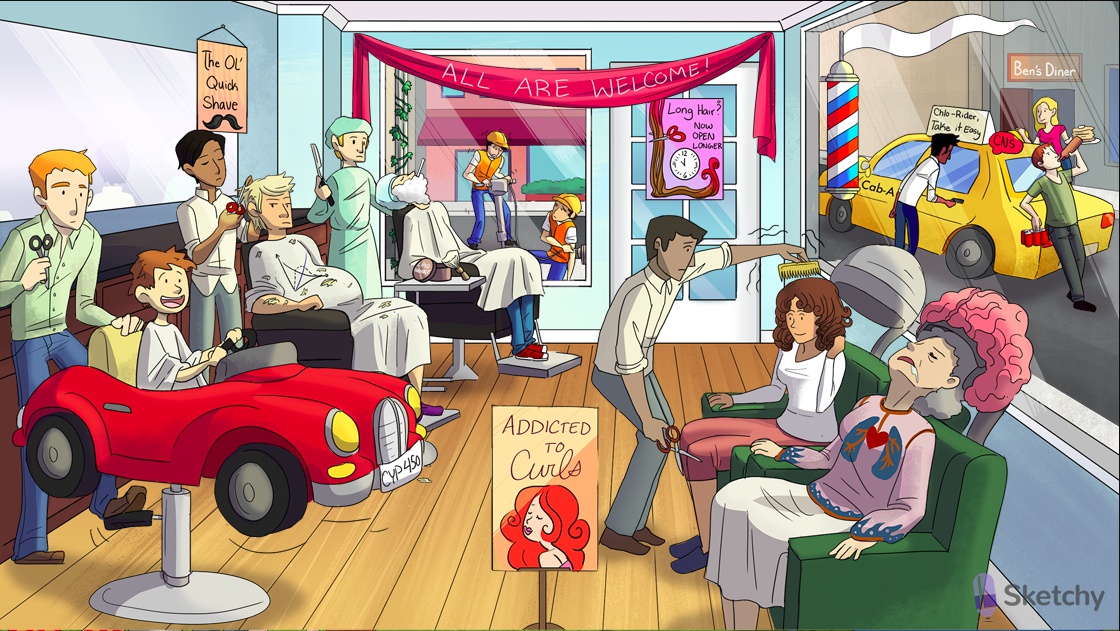Sedatives

- PAM-cakes: “-pam” suffix of benzodiazepines (e.g. diazepam, lorazepam, oxazepam)
- Fast ox: oxazepam (a short-acting benzodiazepine)
- “All A.M.”: “-olam” suffix of short-acting benzodiazepines (triazolam, alprazolam, midazolam)
- “Addictive flavor”: benzodiazepines have the potential to cause addiction (more common with short-acting agents)
- Liver spot: short acting benzodiazepines are metabolized by the liver (long acting agents form active metabolites) (cirrhosis may lead to over sedation )

- Cab-A: benzodiazepines bind to an allosteric site on the GABA-A receptor (inhibitory)
- CNS light: benzodiazepines potentiate/enhance GABA-A transmission in the CNS
- “Chlo-Rider”: the GABA-A receptor is a chloride channel, increased Cl conductance hyperpolarizes and inhibits depolarization
- “Take it easy”: GABA (with glycine) is a major inhibitory neurotransmitter in the CNS
- “Open more frequently”: benzodiazepines increase the frequency of ion channel opening


- Alcoholic on Cab-A: alcohol binds the GABA-A receptor at a separate allosteric site

- Hangover special: benzodiazepines treat alcohol withdrawal
- Long tapering flag: long-acting benzodiazepines (e.g. diazepam, chlordiazepoxide, flurazepam) are useful in the treatment of alcohol withdrawal
- Ivy: IV administration of benzos is useful for the management of alcohol withdrawal, seizures, and anesthesia

- Alcohol withdrawal symptoms (8-12 hours) - insomnia, tremulousness, anxiety, autonomic instability
- Alcohol withdrawal symptoms (12-48 hours) - seizures
- Alcohol withdrawal symptoms (48-96 hours) - delirium tremens (fever, disorientation, severe agitation)

- Status epilepticus (SE) is an epileptic seizure of greater than five minutes or more than one seizure within a five-minute period
- Unplugging jackhammer: benzodiazepines treat status epilepticus

- Intubated customer: IV benzos can be used in general anesthesia (muscle relaxation, amnesia)
- “Lite”: IV benzos can induce conscious sedation for minor procedures and surgeries
- Question mark hat: benzodiazepines can cause anterograde amnesia (useful during conscious sedation)
- Sleeping customer: benzodiazepines treat insomnia (not first line due to side effect of physical dependence)
- Crying kid in pajamas: benzodiazepines treat parasomnias in children (e.g. sleepwalking, night terrors)
- Relaxing chair: benzodiazepines treat spasticity caused by upper motor neuron disorders (e.g. MS, stroke, spinal cord trauma, tetanus)
- Anxious customer: benzodiazepines treat generalized anxiety disorder (GAD) (SSRIs and SNRIs are first line)
- The Scream: benzodiazepines treat panic disorder (SSRIs and SNRIs are first line)

- All are welcome: benzodiazepines can cause tolerance (downregulation of GABA-A)
- Disoriented old man: elderly patients are more sensitive to the side effects of benzodiazepines (including somnolence, confusion, disorientation)
- Unbalanced stack: benzodiazepines can cause central ataxia (causing falls in the elderly)
- Bee swatter smacking head: benzos should be avoided with 1st gen. antihistamines and other CNS depressants (e.g. alcohol, barbs, neuroleptics).
- Decreased CNS with normal vitals
- Barbershop next to Cab-A: barbiturates bind the GABA-A receptor at a separate allosteric site

- Antagonizing fluffy muzzled dog: flumazenil (competitive antagonist at the BZD receptor) reverses benzo induced sedation (but precipitates seizures)
Nonbenzodiazepine hypnotics, melatonin, ramelteon

- 3 Zs: Zolpidem, Zaleplon, esZopiclone (nonbenzodiazepine hypnotics)

- Cab-A: nonbenzodiazepine hypnotics (e.g. zolpidem) bind to an allosteric site on the GABAA receptor
- “Chlo-Rider”: the GABAA receptor is a chloride channel
- CNS light: benzodiazepines potentiate GABAA transmission in the CNS
- “Take it easy”: GABA (with glycine) is a major inhibitory neurotransmitter in the CNS
- Grabbing same cab handle: nonbenzodiazepine hypnotics and benzos bind to the same allosteric site on GABA-A
- Alcoholic on Cab-A: alcohol binds the GABAA receptor at a separate allosteric site
- Barbershop next to Cab-A: barbiturates bind the GABAA receptor at a separate allosteric site


- ” fast”: zaleplon and zolpidem have a rapid onset of action
- Quick jump and fall: nonbenzodiazepine hypnotics have a short duration of action
- Liver spot: zaleplon and zolpidem are rapidly metabolized by the liver, P450 system
- “Fall asleep”: zaleplon and zolpidem treat sleep onset insomnia (eszopiclone has the longest half life and is effective for both sleep onset and sleep maintenance insomnia)

- Sleeping: nonbenzodiazepine hypnotics treat insomnia

- Disoriented old man: elderly patients are more sensitive to the side effects of nonbenzodiazepine hypnotics (e.g. cognitive impairment and delirium)
- Unbalanced stack: nonbenzodiazepine hypnotics can cause central ataxia (causing falls in the elderly)
- “Cannot combine with other CoupoNS”: avoid use with other CNS depressants
- Bee swatter smacking head: avoid use with other CNS depressants (e.g. 1st generation antihistamines, alcohol, benzos, barbs)

- “not tolerated”: nonbenzodiazepine hypnotics are less likely to cause tolerance
- “break bad habits”: nonbenzodiazepine hypnotics are less likely to cause withdrawal symptoms and dependence

- Antagonizing fluffy muzzled dog: flumazenil (competitive antagonist at the BZD receptor) reverses the sedative actions of nonbenzodiazepine hypnotics (but precipitates seizures)

- “melt away”: melatonin and ramelteon (a melatonin receptor agonist) treat insomnia
- Dark and light: melatonin receptors maintain circadian rhythm
- Nucleus above “X”: MT1 and MT2 melatonin receptors are located in the suprachiasmatic nucleus of the hypothalamus (activated by ramelteon)

- Peacefully sleeping elderly: ramelteon has few side effects and are safe in geriatric patients
Barbiturates

- Cab-A: barbiturates bind to an allosteric site on the GABA-A receptor
- Ben’s diner next to Cab-A: benzodiazepines bind the GABA-A receptor at a separate allosteric site
- Alcoholic on Cab-A: alcohol binds the GABA-A receptor at a separate allosteric site
- “Chlo-Rider”: the GABA-A receptor is a chloride channel
- CNS light: barbiturates potentiate GABA-A transmission in the CNS
- “Take it easy”: GABA (with glycine) is a major inhibitory neurotransmitter in the CNS


- “Open longer”: barbiturates increase the duration of opening of the GABAA receptor
- Long tapering flag: barbiturates have long durations of action (“hangover” effects more common)

- “The ol’ quick shave”: thiopental has a rapid onset and short duration of action (highly lipid soluble) <30 s
- Intubated customer: IV thiopental can be used for induction of anesthesia
- Ivy: IV administration of barbiturates is useful for induction of anesthesia (thiopental) and management of seizures (phenobarbital)
- Hair “redistributed” onto arms and belly: plasma levels of thiopental decrease rapidly due to redistribution to skeletal muscle and adipose
- Decay line: rapid decay of plasma thiopental levels (due to redistribution)
- Brief peak: rapid accumulation of thiopental in brain tissue and rapid redistribution
- Growth line: rapid accumulation of thiopental in skeletal muscle and adipose (recovery from anesthesia)

- Unplugging jackhammer: IV phenobarbital can be used to treat seizures

- Perm is done!: primidone (a barbiturate used to treat seizures and essential tremor)
- Tremulous hand: primidone treats essential tremor (first line with propranolol)

- Collapsed heart and lungs: barbiturates can cause profound cardiac and respiratory depression
- Fainting: barbiturates can cause hypotension
- Brain hair dryer: barbiturates can cause severe CNS depression (e.g. coma) and should be avoided in the elderly
- “All are welcome”: chronic barbiturate use leads to tolerance
- “Addicted”: chronic barbiturate use leads to physical dependence

- Activated chrome bumper: barbiturates (e.g. phenobarbital) are potent inducers of the cytochrome P450 system
Links to this note



























